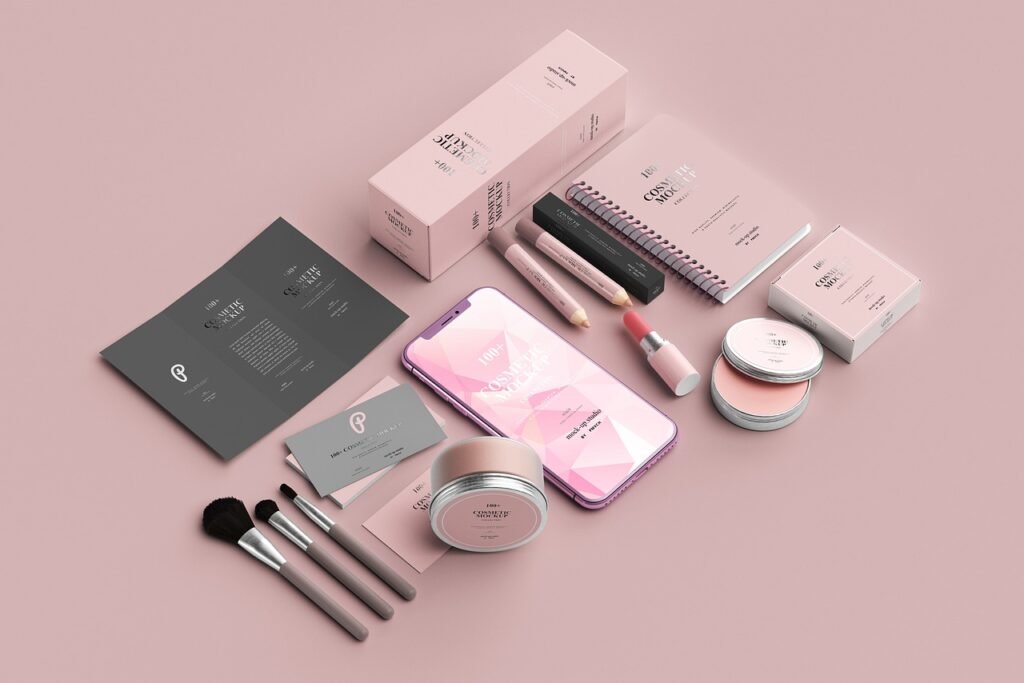This Article has been revised, edited and added to, by Poulomi Chakraborty.
- The Art of Crafting a Visual Identity in Fashion
- The Power of a Logo
- Color Schemes That Speak
- Typography Tells a Tale
- Establishing a Cohesive Brand Aesthetic
- Prioritizing Visual Consistency Across All Platforms
- Leveraging Visuals to Stand Out in a Competitive Market
- Continuous Evolution and Adaptation
- Actionable Steps for Implementing a Strong Visual Identity
- Storytelling Through Fashion
- Engaging Through Experiences
- Maximizing Impact Through Social Media
- Strategic Brand Collaborations
- Conclusion: The Dynamic World of Fashion Branding
In the bustling world of fashion, standing out is as crucial as the design of the clothes themselves. Brands strive not only to appeal to their audience’s style preferences but also to engrain a unique brand identity that resonates on a personal level. How exactly do fashion labels carve out these distinctive identities? Let’s dive into the intricate world of fashion branding, exploring the tactics that transform ordinary labels into iconic symbols of style and expression.
The Art of Crafting a Visual Identity in Fashion

The Power of a Logo
At the heart of any fashion brand’s identity lies its logo—a small but mighty symbol that communicates the essence of the brand to the world. Consider the iconic logos of brands like Chanel and Nike. Chanel’s interlocked ‘C’s and Nike’s swoosh are not just logos; they are symbols that carry the weight of the brand’s entire history, ethos, and aesthetic. They represent more than just clothes; they convey a lifestyle.
Case Study: Chanel vs. Nike
Chanel, primarily known for luxury and sophistication, uses its logo to convey a sense of elegance and timelessness. Its simple, symmetrical design appeals to those who appreciate classic luxury. In contrast, Nike’s swoosh embodies dynamism and performance, appealing to a vibrant, active demographic. These logos are visual shorthand for what the brands stand for.
Color Schemes That Speak
Colors play a crucial role in fashion branding, influencing perception and emotions. The colors chosen by a brand are a direct communication tool that influences how consumers feel about the brand’s products. For instance, black can signify sophistication and luxury, often used by high fashion brands like Gucci and Prada. On the other hand, bright and vibrant colors might be more typical of a brand like H&M, which aligns itself with youthful exuberance and casual style.
The Impact of Consistency
The key to effective use of color in branding lies in consistency. Consistent use of color not only reinforces brand recognition but also strengthens emotional associations. When a fashion brand consistently uses the same colors across all its platforms—be it in-store, online, or in marketing materials—it creates a cohesive and memorable brand experience. This consistency helps embed the brand in the consumer’s mind, making it more likely that they will return to the brand in the future.
Typography Tells a Tale
Just as with colors, the fonts used by a brand play a significant role in shaping its identity. Typography in fashion branding must align with the overall tone and values of the brand. A luxury brand might use clean, elegant serif fonts to express its heritage and attention to detail, whereas a trendy, edgy brand might opt for bold, striking sans-serif fonts to make a strong impression.
Typography in Action
Take, for example, Burberry’s use of a bespoke serif font which reflects its rich heritage and British identity. Conversely, Supreme’s bold, italicized logo taps into urban culture and appeals to a younger, more rebellious audience. Each typographic choice reinforces the brand’s unique identity and helps it stand out in a crowded market.
Establishing a Cohesive Brand Aesthetic
For startup founders venturing into the fashion industry, creating a cohesive brand aesthetic is pivotal. This aesthetic is the visual language through which the brand communicates, encompassing everything from the logo and color palette to the design of the products themselves.
Founders must ensure that every visual element is harmonized to express the brand’s core values and appeal to the target demographic. This starts with a thorough understanding of the brand’s story and ethos, which should be the foundation of all design decisions.
Consider how every visual element can reinforce this story, whether it’s through the elegance of minimalist designs for a luxury brand or the rugged detailing appropriate for an outdoor apparel line.
Prioritizing Visual Consistency Across All Platforms
In today’s digital age, maintaining visual consistency across various platforms is essential for brand recognition and recall. This means that your website, social media profiles, product packaging, and all other customer touchpoints should have a uniform appearance that reflects your brand’s aesthetic.
For instance, if your brand identity is centered around sustainability, using natural tones and textures can convey this commitment across all platforms. Founders should meticulously plan out not only the primary elements such as the logo and primary color but also secondary visuals including typeface choices and additional color palette options that complement the primary selections.
This level of detail ensures that no matter where a potential customer encounters your brand, they receive the same message and feel.
Leveraging Visuals to Stand Out in a Competitive Market
In a crowded market, having a distinctive visual identity can be the difference between blending in and standing out. Consider employing unique design elements that set your brand apart.
This could be an unconventional logo design, an unexpected color scheme, or a distinctive photographic style that makes your product images instantly recognizable. For example, a startup might use hand-drawn illustrations in its branding materials to evoke a sense of craftsmanship and authenticity that resonates with a niche market.
Additionally, think about how these elements can be applied in innovative ways across different media to capture the attention of potential customers and leave a memorable impression.
Continuous Evolution and Adaptation
The visual identity of a brand is not static; it should evolve as the brand grows and as market trends change. Startup founders should remain open to refining their brand’s visual elements to keep up with new aesthetic trends and changes in consumer preferences.
This doesn’t mean a complete overhaul but rather subtle updates that keep the brand modern and relevant. Keeping a finger on the pulse of design trends and regularly soliciting feedback from customers can guide these updates effectively.
Actionable Steps for Implementing a Strong Visual Identity
Finally, to translate these strategies into action, startup founders should begin by conducting extensive market research to define their unique value proposition and understand their audience deeply.
Following this, engaging with professional designers or branding agencies who can translate this understanding into a compelling visual identity might be a worthwhile investment.
Testing different visual concepts through focus groups or A/B testing on social media can provide valuable insights that refine the brand’s visual direction before a full-scale launch. Regularly revisiting and revising the brand’s visual strategy as the company grows will ensure the identity remains strong and relevant.
By taking these strategic steps in crafting a visual identity, fashion startups can create a compelling brand presence that captivates and retains their target audience, setting a solid foundation for brand growth and success.
Storytelling Through Fashion

Building a Brand Narrative
One of the most powerful tools in a fashion brand’s arsenal is its ability to tell a story. Storytelling not only enriches the brand but also creates an emotional connection with consumers. It’s about weaving a narrative that aligns with the values and aspirations of its target audience, thereby fostering a community of loyal followers.
The Role of Heritage and Innovation
Consider a brand like Louis Vuitton, which skillfully blends its rich heritage with innovation. The story of its founding, the quality of craftsmanship, and its journey through the ages appeal to those who value tradition and luxury. Meanwhile, its innovations in design and technology keep it relevant and exciting for new generations.
Visual Storytelling in Campaigns
Fashion campaigns are the perfect medium for storytelling. Through powerful imagery and thematic campaigns, brands can communicate much more than the clothes they are selling. They can express attitudes, evoke feelings, and articulate the brand’s ethos.
Example of Effective Campaigns
Gucci’s campaigns often feature a retro aesthetic that nods to different eras while still feeling modern and fresh. This blend of the old and new helps to tell a story of timeless style that appeals to both nostalgic older consumers and trend-seeking younger shoppers.
Crafting a Compelling Brand Narrative
For startup founders in the fashion industry, crafting a compelling brand narrative is not just about telling a story—it’s about telling the right story in a way that deeply resonates with your target audience.
This narrative should be intricately woven into every aspect of your brand, from the product designs and marketing materials to the about page on your website and the posts you share on social media.
It should articulate not just what you sell, but why you sell it, who you are as a brand, and what you stand for. For instance, if sustainability is a core value, your story should highlight the journey of each product from design to delivery, emphasizing the ethical considerations and sustainable materials involved.
Utilizing Emotional Connections
Emotional connections are powerful drivers for customer loyalty and brand advocacy. Start by identifying the emotions you want your brand to evoke—whether it’s joy, a sense of belonging, inspiration, or empowerment. Use these emotions to guide the creation of all visual and textual content.
For example, a brand that aims to empower women might share customer stories that highlight personal achievements or moments of strength, thereby creating an emotional narrative that other customers can aspire to and see themselves in.
Integrating Storytelling into Marketing Campaigns
Integrating storytelling into your marketing campaigns can significantly enhance their effectiveness. Campaigns should not only feature products but also tell stories that align with the campaign’s goals. Whether it’s a seasonal campaign, a product launch, or a brand awareness campaign, the narrative should be clear and impactful.
For a startup, video campaigns can be particularly effective as they are highly engaging and capable of conveying complex emotional and narrative depth within a short span. Consider creating short films or video series that bring your brand’s story to life, showing your products in real-life scenarios that align with your narrative.
Engaging Content Strategies
Engaging content strategies are vital for storytelling. This involves more than just writing product descriptions and blog posts; it’s about creating a variety of content that can engage users across multiple platforms.
This could include behind-the-scenes content, designer interviews, customer stories, and more. Each piece of content should add a layer to your brand’s story, offering insights into your values, your processes, or the lifestyle that your brand promotes.
For example, a fashion startup focusing on adventure wear might share customer stories and photos from exotic locations, reinforcing the narrative of adventure and exploration.
Leveraging Digital Platforms for Broader Story Distribution
Digital platforms offer vast opportunities for storytelling. Beyond your own website and social media, consider other platforms where your target audience might consume content. This could include fashion blogs, online magazines, and digital fashion events.
Collaborations with influencers who align with your brand’s values can also help tell your story to a broader audience. Additionally, consider the power of podcasts or webinars where you can discuss your brand’s journey, the challenges you’ve faced, the milestones you’ve achieved, and the impact you hope to have on the fashion industry.
By strategically implementing these storytelling elements, fashion startups can create a strong emotional and psychological connection with their audience, building a loyal customer base that feels deeply connected to the brand’s values and vision.
Engaging Through Experiences

The Importance of Immersive Experiences
In the digital age, creating memorable brand experiences is crucial. These experiences can range from pop-up shops and exclusive events to interactive online experiences. By engaging the senses, fashion brands create touchpoints that deepen the emotional bond with their audience.
Pop-Up Shops and Their Impact
Pop-up shops offer a unique opportunity for brands to showcase their personality and engage directly with consumers. These temporary events can create buzz, test new markets, or highlight a special collection. They are often crafted to be highly Instagrammable, encouraging visitors to share their experiences online, thus amplifying the brand’s reach.
Leveraging Technology
Innovative use of technology can also enhance the brand experience. Augmented reality (AR) try-ons, virtual showrooms, and AI-driven personalization are just a few examples of how brands can use technology to create a more engaging and personalized shopping experience.
Case Study: Nike’s Digital Innovation
Nike has embraced technology by integrating AR into its app, allowing customers to try sneakers virtually. This not only offers a fun and engaging experience but also provides practical value by helping consumers choose the right product, thereby reducing return rates.
Creating a Memorable Brand Experience
For startup founders in the fashion industry, creating a memorable brand experience is essential for differentiating themselves in a competitive market. This involves more than just selling products; it’s about offering an experience that immerses customers in the brand’s world.
One effective approach is to design an in-store experience that goes beyond traditional retail. Consider the layout, decor, and sensory elements of your store. For example, a startup focusing on beachwear might create a store environment that evokes the feel of a beach resort, complete with sand-textured floors, ocean sounds, and a tropical scent.
Leveraging Pop-Up Events for Brand Engagement
Pop-up events are an excellent way for fashion startups to generate buzz and test market reactions without committing to a permanent retail space. These events can be themed to reflect the brand’s aesthetic and values, providing an immersive experience that allows customers to physically interact with the product.
Additionally, incorporating interactive elements such as live demonstrations, workshops, or fashion shows can enhance engagement and make the event memorable. Partnering with other brands that share a similar target audience but do not directly compete can also expand your reach and add value to the event.
Integrating Technology for Enhanced Interactions
In the digital era, integrating technology can greatly enhance the customer experience. For fashion startups, this could include the use of augmented reality (AR) to allow customers to try on clothes virtually before buying.
Developing a mobile app that lets users design or customize their clothing can also provide a unique interactive experience that engages customers and gives them a role in the creative process. Additionally, leveraging virtual reality (VR) during events to transport users to a virtual fashion world could offer an innovative and engaging shopping experience.
Personalization as a Key Differentiator
Personalization is a powerful tool in building customer loyalty and increasing engagement. Fashion startups should consider how they can personalize the shopping experience, whether through customized product offerings, personalized marketing messages, or tailored customer service.
For instance, offering bespoke tailoring services online, where customers can input their measurements and choose design elements to customize their garments, can make them feel more connected to the brand.
Similarly, using data analytics to understand customer preferences and behaviors can help in crafting personalized email marketing campaigns that speak directly to the needs and desires of each customer.
Building Community Through Shared Experiences
Creating a sense of community among your customers can significantly enhance brand loyalty. This can be achieved by hosting community events, such as fashion workshops, speaker series, or networking events that bring like-minded individuals together.
Online platforms can also be used to foster this community feeling by encouraging customers to share their style stories or participate in fashion challenges. Creating a brand ambassador program where loyal customers receive perks for spreading the word about your brand can also stimulate community growth and engagement.
By focusing on these strategic elements of experience engagement, fashion startups can create strong emotional connections with their customers. This not only enhances brand loyalty but also sets the foundation for a vibrant, engaged customer base that feels a part of the brand’s journey and success.

Related: Check out our free SEO suite

Maximizing Impact Through Social Media
Harnessing the Power of Platforms
Social media offers fashion brands an unparalleled opportunity to amplify their presence and connect with a global audience. Each platform serves a different purpose, allowing brands to craft a multi-faceted social media strategy that showcases various aspects of their identity.
Instagram: A Visual Showcase
Instagram, with its visually driven format, is ideal for fashion brands. It’s a place to display the latest collections, share behind-the-scenes content, and highlight brand aesthetics. Instagram Stories and Reels provide additional layers of engagement through time-limited offers and dynamic content, helping brands maintain a fresh and relevant presence.
Influencer Collaborations
Working with influencers is a strategic way for brands to expand their reach and credibility. Influencers act as brand ambassadors, lending their voice and following to the brand’s narrative. The key is selecting influencers whose values align with the brand, ensuring authenticity in the partnership.
Example: Zara’s Influencer Strategy
Zara, known for its trendy and affordable fashion, often collaborates with fashion influencers who mirror its stylish yet accessible brand identity. These collaborations allow Zara to reach a wider audience while maintaining a high level of style and relevance in the fast-paced fashion market.
Developing a Targeted Social Media Strategy

For fashion startup founders, developing a targeted social media strategy is critical to connecting with the right audience effectively. This involves not only choosing the right platforms based on where your target customers spend their time but also tailoring the content to meet the specific interests and needs of that audience.
For instance, if your brand targets millennials, platforms like Instagram and TikTok are ideal due to their large, engaged young user bases. On these platforms, visual storytelling and short, engaging video content can perform exceptionally well.
Utilizing Visuals to Create Brand Identity
Visual content is the backbone of effective social media branding, especially in fashion. High-quality, consistent visuals that reflect the brand’s style, values, and message are essential. It’s important to maintain a consistent aesthetic theme across all posts, which can help reinforce brand identity and improve recognition.
This might involve a consistent color scheme, a particular style of photography, or a recurring theme in the content itself, such as highlighting sustainable practices if that’s a core part of your brand ethos.
Engaging Authentically with Followers
Engagement is not just about pushing content to followers; it’s a two-way interaction. Responding to comments, messages, and engaging with customers’ posts can significantly enhance loyalty and brand perception.
Hosting live sessions where founders or designers talk about their process, showcase new products, or conduct Q&A sessions can add a personal touch that many followers appreciate. This authentic interaction helps build a community around the brand, making followers feel valued and part of the brand’s journey.
Leveraging User-Generated Content
Encouraging user-generated content (UGC) is a powerful strategy to enhance engagement and authenticity. UGC can serve as social proof that others enjoy and value the brand, influencing new customers.
Fashion startups can encourage their customers to share photos of themselves wearing the products by creating hashtags, running contests, or featuring user content on the brand’s main social media pages. This not only provides free, authentic content but also makes customers feel involved and appreciated by the brand.
Harnessing the Power of Influencer Partnerships
Collaborating with influencers can help amplify your brand’s reach, particularly when you partner with influencers whose followers align with your target market. When choosing influencers, it’s not just about the number of followers—they should embody the brand’s values and aesthetic.
A well-chosen influencer can introduce your brand to their followers in a way that feels natural and engaging, rather than as a straightforward advertisement. Setting up long-term relationships with influencers as brand ambassadors can provide ongoing benefits, creating deeper associations between their followers and your brand.
By implementing these strategies, fashion startups can effectively use social media to build brand awareness, engage with their audience, and drive sales. Each element of the social media strategy should be thoughtfully planned and aligned with the overall brand strategy to ensure consistency and authenticity in every interaction.
Strategic Brand Collaborations

Collaborating for Enhanced Creativity
Brand collaborations can be a powerful way to inject new energy and broaden a brand’s appeal. By partnering with other brands, artists, or even industries, fashion labels can break into new markets, offer exclusive products, and create buzz.
Cross-Industry Collaborations
A prime example is the collaboration between high-fashion brands and athletic wear companies. For instance, the Adidas by Stella McCartney partnership combines high performance with high fashion, appealing to a demographic that values both fitness and style.
Limited Edition Releases
Limited edition collaborations are particularly effective in creating urgency and exclusivity. They provide fans with something unique, which can not only attract new customers but also reinforce loyalty among existing ones.
Case Study: H&M’s Designer Collaborations
H&M’s partnerships with designers like Karl Lagerfeld and Alexander Wang have been hugely successful. These collections make designer fashion more accessible and create significant media buzz, attracting a surge of customers eager to get their hands on limited edition pieces.
Choosing the Right Collaboration Partners
For startup founders in the fashion industry, choosing the right partners for collaborations is a strategic decision that can significantly impact brand visibility and growth. The ideal collaboration should align with the brand’s values and appeal to its target audience, but it should also bring something new to the table.
A partner that complements rather than competes with your offerings can help tap into new customer segments. For instance, a startup specializing in casual wear might collaborate with a footwear brand that appeals to a similar demographic but doesn’t currently offer clothing.
Integrating Brand Stories for a Cohesive Campaign
When two brands collaborate, it’s crucial to integrate their stories in a way that feels natural and cohesive. This involves more than just co-branding products; it requires a unified approach to marketing and storytelling.
Creating a campaign that weaves together the narratives of both brands can enhance the authenticity of the collaboration and make it more engaging for customers. For example, if a sustainable fashion brand collaborates with an eco-friendly accessories brand, the campaign could focus on their shared commitment to environmental conservation, telling a story that resonates deeply with eco-conscious consumers.
Leveraging Each Other’s Strengths
A successful collaboration leverages the strengths of each partner for mutual benefit. This could mean combining one brand’s innovative design capabilities with another’s advanced technology or robust distribution network.
Before entering into a collaboration, it’s beneficial to identify what each party brings to the table and how these strengths can be used to enhance the collaboration’s success. Clear communication and shared goals are key to ensuring that each brand is able to contribute effectively and benefit from the partnership.
Creating Exclusive Offerings to Drive Interest
One of the most effective ways to generate buzz and excitement around a brand collaboration is through the creation of exclusive products or limited edition collections. These offerings should be designed to highlight the best aspects of both brands, creating something unique that can’t be found elsewhere.
Exclusivity adds an element of rarity and desirability that can attract press attention and drive consumer demand, helping to boost brand visibility and perceived value.
Measuring the Success of Collaborations
To truly benefit from brand collaborations, it’s crucial to measure their success. This can be done by tracking sales figures, customer engagement, and media coverage, as well as by gathering customer feedback on the collaboration.
Understanding what works and what doesn’t allows you to refine future partnerships and maximize their effectiveness. Additionally, consider the long-term impacts of the collaboration on brand perception and customer loyalty, which can be just as valuable as immediate sales boosts.
By strategically selecting partners, integrating brand stories, leveraging each partner’s strengths, creating exclusive offerings, and measuring the outcomes, fashion startups can maximize the benefits of strategic brand collaborations.
These partnerships, when executed effectively, can significantly enhance brand reach, enrich product offerings, and build a stronger connection with target audiences.
Conclusion: The Dynamic World of Fashion Branding
Fashion branding transcends mere aesthetics to forge deep connections with audiences worldwide. It is a meticulous blend of visual elements, compelling storytelling, and innovative engagement strategies. Brands that master this blend do not just sell clothes—they sell lifestyles, ideals, and dreams. They leverage every tool at their disposal, from the timeless allure of a well-crafted logo to the cutting-edge use of technology in shopping experiences.
Social media platforms and strategic collaborations further amplify their identities, allowing them to reach broader audiences and maintain relevance in an ever-changing market. Ultimately, the most successful fashion brands are those that create a coherent identity that resonates on both an emotional and aesthetic level, crafting a narrative that consumers are eager to be a part of. As we continue to witness the evolution of fashion branding, one thing remains clear: the brands that can tell the most compelling stories and create the most engaging experiences will continue to lead and define the industry.
Read Next
- The Power of Purple in Branding: Why This Color Resonates with Audiences
- Design Branding: Merging Aesthetics with Brand Identity for Maximum Impact
- Beauty Branding: The Secrets Behind Successful Cosmetic Brands
- Tailor Branding: How Customization Elevates Brand Perception
- Tequila Branding: The Art of Crafting a Memorable Spirit Brand






















Comments are closed.